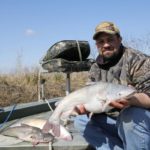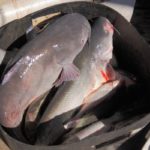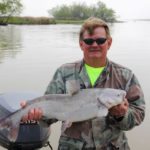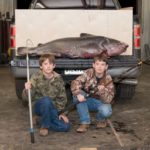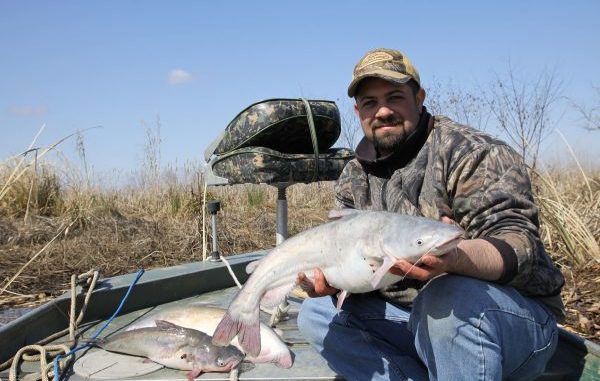
Catfishing isn’t just a lazy, summertime pursuit. The spring is one of the best times to get out and snag a big blue cat, and here are some thoughts on getting in on the action.
My father-in-law was a marsh man who dreaded coming home from down the bayou after trapping season.
In fact more than dread it: He hated it.
Doing anything to extend his stay, right around mid-March he’d put out spanner lines along the coast near the Atchafalaya Delta Wildlife Management Area and commercially fish blue catfish.
One of the things I learned by watching him was when he put out lines it was time for me and Mrs. Flores to get in the boat with our rod and reels.
The bayous are all open along the coast at this time of year, because virtually every water hyacinth is dead or close to it from the cold winter weather.
It’s also the time of year when blue catfish are really active, and it’s not uncommon for catfish anglers to sit in one location and fill up an ice chest during a morning outing.
My father-in-law, James Duay, is not around these days, having succumbed to cancer several years ago. He’s not here to tell me the caisse vivre (the crate where the fish were kept alive) was full.
Or, moreover, to let me know he sold over 100 pounds of fish at the dock that day so I’d better hurry up and get down there before he catches them all.
Times change, but each spring I always know when it’s time. No doubt, his prodding was designed to instill something in me that couldn’t be erased from my internal time clock, and each spring I’ll slowly idle along Big and Little Beach bayous looking for likely spots to fish.
The expanse of marsh in the area has become a sea of purple iris in full bloom by early March. Huge alligators, just coming out of their holes for the first time since winter, slowly slide into the cool water as you round each bend.
And the coast is alive with shorebirds like dowitchers, stilts and plovers.
My wife Christine is a drop-rig, tight-line angler with a sensitive touch, who talks to catfish to coax them to bite.
Her technique reminds me of a time when every kid in our generation took two vegetable cans and stretched strings between them to make homemade telephones.
I truly believe that when she is tight-line fishing for catfish her voice goes down the 15-pound-test Trilene flourocarbon loaded on her spincast reel the catfish hear her enticement the same way those cans worked.
Never have I been on a trip with her when this Neptunian conversation doesn’t happen and a blue cat winds up in the boat.
“Just don’t play with it — take it,” Christine will say.
The next thing you know, my 5-foot, 2-inch spouse, gives a lip-ripping yank on her rod similar to Kevin VanDam setting the hook on a Lake Cataouatche bass.
At that very instant, a “woo-hoo” that I find only girls can actually do correctly, comes from her and another catfish winds up on ice.
She’s also someone who knows what works for her and sticks with it.
“Where are my hooks?” she’ll often mutter when digging through our tackle box.
“What hooks?” I’ll reply from the opposite end of the boat, acting like I’m fishing but really wondering if I picked up a few packs since the last time we fished.
“You know! My hooks,” she’ll insist.
By “my hooks,” what she means are O’Shaughnessay 2/0 hooks of any brand.
O’Shaughnessay hooks are simply a solid dead-bait hook. The eyes are large, which makes it easier to tie or clip into a drop rig. Their design is durable, which makes them able to withstand the rigors large blue catfish put the hook through.
And O’Shaughnessays also hold bait well.
For her drop rig, she’ll also use a ¾-ounce pyramid, bass or bank sinker to ground her tight-line communication system. The key is matching the sinker to the current.
Though two of our favorite tributaries to fish are Big and Little Beach bayous that open into Atchafalaya Bay, big deepwater bayous are always preferred when fishing blue cats.
These two bayous south of Franklin, though not extremely wide, are deep right up to where they meet the bay.
A look at the Louisiana state records for blue catfish reveals the top four blue catfish were caught in the deep waters of the Mississippi River
The Atchafalaya River holds one spot in the Top 10, but it doesn’t mean a March catfisherman’s next cast won’t put him in the money, if records are your thing.
These deeper blue cat waters will see sinkers go to as much as 4 ounces due to the swift current of these rivers. In March of 2014, 12-year-old Lawson Boyte caught the state-record blue — it weighed 114 pounds — in the heavy current of the Mississippi River near Lake Providence.
When considering matching the weight to the current, the Oak Grove High School student said she went very heavy.
“Me, my cousin and uncle were fishing in 20 to 30 feet of water using cut shad for bait,” he said. “We used a 5/0 hook and 3-ounce lead weight.
“I felt something heavy tug on my line and hollered, ‘Ya’ll get out of my way!’”
Lawson’s 9-foot Shakespere Ugly Stick, Penn reel loaded with 65-pound-test braided line, hook size and weight all matched the conditions he was fishing: In this case the wide deep waters of the Mississippi River.
Boyte learned how to reel in big fish from one of his uncles, who once took him deep-sea fishing.
“I got him to the surface, and when I saw it I thought I wasn’t going to get it in,” the young angler said. “My Uncle Jim always has a gaff hook in his boat; he gaffed him and got it into the boat.
“We looked at it and didn’t think it was a state record. We were thinking about 93 pounds. When we got it back to the truck, we googled the weight on the cell phone and found out the state record was 110 pounds.”
Boyte said he wasn’t finished.
“There are a lot bigger ones out there,” he said. “I’m going to try and beat the record, and hopefully someday I will.”
Bayou Vista resident Brian Rock fishes the deep waters of Bayou Chene where it meets the Atchafalaya River in March and, like Lawson, he said he fishes large rigging because big blue catfish roam that part of the river.
“In the last two years, six 35- to 55-pound catfish have come out of the Chene, and March is a good time to be fishing this part of the river for the big ones,” Rock said. “I’ll rig a steel leader to my line or use a heavy nylon leader I make myself and an 8/0 hook with cut mullet, because you gotta go prepared for the big ones.”
He said the warming weather makes figuring out where the fish will be predictable.
“The daytime temperatures are in the 60s, so you want to be fishing the edge of drop-offs with a heavier weight, near the shallow flats of Sweet Bay Lake where they meet the Chene downriver,” he explained.
